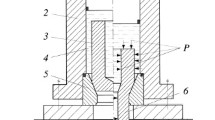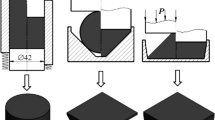Abstract
A promising direction in the development of technologies is the search and study of new stamping schemes that improve the quality of parts and expand the possibilities of cold deformation processes. From the point of view of reducing the workload on the tool, the most perspective way to obtain hollow cylindrical parts is combined extrusion. Combined schemes can be attributed to methods that provide a significant expansion of the possibilities of cold forging technologies. The disadvantage of methods for the extrusion of hollow parts is the heterogeneity of mechanical properties, which is especially evident in hollow products with a large bottom thickness. The deformation process is carried out according new method in two steps to reduce the irregularity of strain. In the first step, backward extrusion of the hull wall and forward extrusion are simultaneously performed with the formation of a technological ledge in the bottom part of the hull, and in the second step, the metal is displaced from the ledge back into the bottom part of the hull. However, this raises the question of assessing the deformability of the workpiece. The presence in this process of nonmonotonic sign-alternating deformation significantly complicates the determination of the stress-strain state and the assessment of deformability. The article proposes a calculation algorithm that makes it possible to take into account the influence of nonmonotonic plastic deformation on the value of the used plasticity resource. This algorithm includes determining the kinematic characteristics of deformation using mixed Euler and Lagrangian coordinates, estimating the stress-strain state based on the model of an anisotropically hardening body, and determining the value of the used plasticity resource by applying a criterion that allows to take into account the volumetric stress state and the influence of the third stress tensor invariant on the damage accumulation process. The results of the experimental study and finite element simulation of a two-stage extrusion process are also given, confirming the advantage of the combined process in reducing power parameters and deformation unevenness. The presented calculating approach is used to assess the deformability of the workpiece and the value of the used plasticity resource in the process of combined extrusion and can be useful for analyzing methods of intensive plastic deformation.







Similar content being viewed by others
Data availability
Not applicable.
Code availability
Not applicable.
References
Hrudkina N, Aliiev I, Markov O, Savchenko I, Sukhovirska L, Tahan L (2021) Designing a kinematic module with rounding to model the processes of combined radial-longitudinal extrusion involving a tool whose configuration is complex. East-Eur J Enterp Technol 2(1-110):81–89. https://doi.org/10.15587/1729-4061.2021.227120
Markov OE, Aliiev IS, Aliieva LI, Hrudkina NS (2020) Computerized and physical modeling of upsetting operation by combined dies. J Chem Technol Metall 55(3):640–648
Aliieva LI, Markov OE, Aliiev IS, Hrudkina NS, Levchenko VN, Malii KV (2021) Analysis of power parameters of combined three-direction deformation of parts with flange. FME Trans 49(2):344–355. https://doi.org/10.5937/fme2102344A
Kalyuzhnyi VL, Aliieva LI, Kartamyshev DA, Savchinskii IG (2017) Simulation of cold extrusion of hollow parts. Metallurgist 61(5–6):359–365. https://doi.org/10.1007/s11015-017-0501-1
Allieva L, Hrudkina N, Aliiev I, Zhbankov I, Markov O (2020) Effect of the tool geometry on the force mode of the combined radial-direct extrusion with compression. East-Eur J Enterp Technol 2(1-104):15–22. https://doi.org/10.15587/1729-4061.2020.198433
Aliіeva LI (2018) Improvement of combined extrusion processes: monograph. LLC «Tirazh–51», Kramatorsk, p 352 (in Russian)
Beigelzimer Ja E, Efros B, Varyukhin V, Khokhlov A (1994) A continuum model of a structurally-inhomogeneous porous body and its application for the study of stability and viscous fracture of materials deformed under pressure. Eng Fract Mech 48(5):629–640
Kukhar V, Burko V, Prysiazhnyi A, Balalayeva E, Nahnibeda M (2016) Development of alternative technology of dual forming of profiled workpiece obtained by buckling. East-Eur J Enterp Technol 2016(3/7 (81)):53–61. https://doi.org/10.15587/1729-4061.2016.72063
Kraievskyi VO, Mykhalevych VM, Sawicki D, Ostapenko O (2018) Modeling of the materials superplasticity based on damage summation theory. In: Proc. SPIE 10808, Photonics Applications in Astronomy, Communications, Industry, and High-Energy Physics Experiments 2018, 108084S (1 October 2018). https://doi.org/10.1117/12.2501489
Titov AV, Mykhalevych VM, Popiel P, Mussabekov K (2018) Statement and solution of new problems of deformability theory. In: Proc. SPIE 10808, Photonics Applications in Astronomy, Communications, Industry, and High-Energy Physics Experiments 2018, 108085E (1 October 2018). https://doi.org/10.1117/12.2501635
Lebedev AA, Mikhalevich VM (2006) Criterial relationships for residual life assessment of materials. Strength Mater 38(4):348–353. https://doi.org/10.1007/s11223-006-0049-y
Grushko AV, Kukhar VV, Slobodyanyuk YO (2017) Phenomenological model of low-carbon steels hardening during multistage drawing. Solid State Phenom 265:114–123
Puzyr R, Savelov D, Argat R, Chernish A (2015) Distribution analysis of stresses across the stretching edge of die body and bending radius of deforming roll during profiling and drawing of cylindrical workpiece. Metall Min Ind 1:27–32
Sivak R (2017) Evaluation of metal plasticity and research of the mechanics of pressure treatment processes under complex loading. East-Eur J Enterp Technol 6/7(90):34–41. https://doi.org/10.15587/1729-4061.2017.115040
Backhaus G (1981) Constitutive equations for the plastic behaviour of metals and the influence of the deformation induced rotation. Acta Mech 41:793–830
Ogorodnikov VA, Derevenko IA, Aliieva LI (2016) Plasticity resource of metals during cold volumetric forming: monograph. LLC “Mercury-Podillya”, Vinnytsia, p 176 (in Russian)
Funding
The research was funded by the Ministry of Education and Science of Ukraine (grant: number 0123U101703).
Author information
Authors and Affiliations
Contributions
By ISA: determination of the strain rate tensor components using mixed Euler and Lagrangian coordinates.
By RIS: determination of the stress deviator components based on the model of an anisotropically hardening material.
By OEM: determination of the used plasticity resource, taking into account the influence on the plasticity of the third invariant of the stress tensor.
By VNL: developed research method. Experimental and FEM simulation of the two-stage extrusion process
Corresponding author
Ethics declarations
Ethics approval
This manuscript was submitted to only one journal. The submitted work is original and does not have been published elsewhere in any form or language (partially or in full). Results have been presented, honestly, and without fabrication, falsification, or inappropriate data manipulation (including image-based manipulation). The authors adhered to rules for acquiring, selecting, and processing data. Data, text, and theories were the author’s own. Proper acknowledgments of other works were given and summarized.
Consent to participate
Not applicable
Consent for publication
Not applicable
Conflicts of interest
The authors declare no competing interests.
Additional information
Publisher’s Note
Springer Nature remains neutral with regard to jurisdictional claims in published maps and institutional affiliations.
Rights and permissions
Springer Nature or its licensor (e.g. a society or other partner) holds exclusive rights to this article under a publishing agreement with the author(s) or other rightsholder(s); author self-archiving of the accepted manuscript version of this article is solely governed by the terms of such publishing agreement and applicable law.
About this article
Cite this article
Aliiev, I.S., Sivak, R.I., Markov, O.E. et al. The evaluation of workpiece deformability for the process of two-stage extrusion of hollow hull. Int J Adv Manuf Technol 129, 1345–1353 (2023). https://doi.org/10.1007/s00170-023-12353-6
Received:
Accepted:
Published:
Issue Date:
DOI: https://doi.org/10.1007/s00170-023-12353-6




